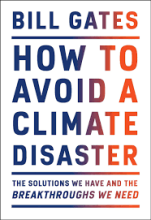Why Zero? - A little is a lot
7 important questions on Why Zero? - A little is a lot
In climate terms, only a change of a few degrees (1 or 2 degrees Celsius/1.8 to 3.6 degrees Fahrenheit) can causes a lot of trouble. Bill Gates describes two examples to indicate this. Name this examples.
- The first example = During the last ice age, the average temperature was just 6 degrees Celsius lower than it's today.
- The second example = During the age of the dinosaurs, the average temperature was 4 degrees Celsius highter than today and there were crocodiles living above the Arctic Circle.
Carbon dioxide is the most common greenhouse gas, but there are others, like nitrous oxide and methane. What is the difference between them?
- Many of these other gases, like oxide and methane, cause more warming than carbon dioxide does, 120 times more warming the moment it reaces the atmosphere.
- But: methane doesn't stay as long as carbon dioxide.
Most people combine all types of greenhouse gases into a single measure known as "carbon dioxide equivalents" (Co2e). Where do we use "carbon dioxide equivalents" for?
- We use carbon dioxide equivalents (Co2e) to account for the fact that some gases trap more heat than carbon dioxide but don't stay around as long.
- Higher grades + faster learning
- Never study anything twice
- 100% sure, 100% understanding
Why isn't, according to Bill Gates, "carbon dioxide equivalents" (Co2e) an good measure?
- What matters is the higher temperature and their impact on humans, instead of the amount of greenhouse gas emissions.
- For an example = gas like methane is much worse than carbon dioxide, because it drives the temperature up immediately. When you use carbon dioxide equivalents, you do not take sufficient account of this short-term effect.
How do greenhouse gases cause warming, according to Bill Gates?
- They absorb heat and trap it in the atmosphere.
- For an example = you've seen the greenhouse effect when your car is sitting outside in the sun. Your shields lets sunlight in, then traps some of that energy. That's why the inside of your car is hotter than the outside temperature.
How can the sun's heat get past greenhouse gases on its way to earth but then get trapped by these same gases in our atmosphere?
- All molecules vibrate and the faster they vibrate, the hotter they are. When certain types of molecules are hit with radiation at certain wavelengths, they block the radiation, soack up its energy, and vibrate faster.
- Not all radiation is on the right wavelengths to cause this effect.
- For an example = sunlight passes right trough most greenhouse gases without getting absorved. Most of it reaces the earth and warms up the planet.
The earth doesn't hold on to energy that is caused by greenhouse gases forever. What does the earth do with this heat?
- It radiates some of the energy bank toward space, and some of this energy is emitted in just the right range of wavelengths to get absorved by greenhouse gases.
The question on the page originate from the summary of the following study material:
- A unique study and practice tool
- Never study anything twice again
- Get the grades you hope for
- 100% sure, 100% understanding
































